Financial Performance Analysis of T-Shirt Ltd Business
VerifiedAdded on 2023/01/04
|16
|3619
|51
Report
AI Summary
This report provides a comprehensive financial analysis of T-Shirt Ltd. It begins with an introduction to business finance and then delves into the company's performance, examining the statement of profit and loss and the statement of financial position. Key financial ratios such as gross profit ratio, net profit ratio, and operating profit ratio are calculated and analyzed to assess the company's profitability and operational efficiency. The report also analyzes the balance sheet, including current ratio, receivable turnover ratio, and payable turnover ratio, to evaluate the company's liquidity and efficiency in managing its assets and liabilities. Furthermore, the report explores the concepts of accrual versus cash accounting, highlighting their advantages and disadvantages. Finally, the report discusses budgeting and the benefits of forming a limited company. The analysis aims to provide insights into T-Shirt Ltd's financial health and management practices.

Business Finance
Paraphrase This Document
Need a fresh take? Get an instant paraphrase of this document with our AI Paraphraser
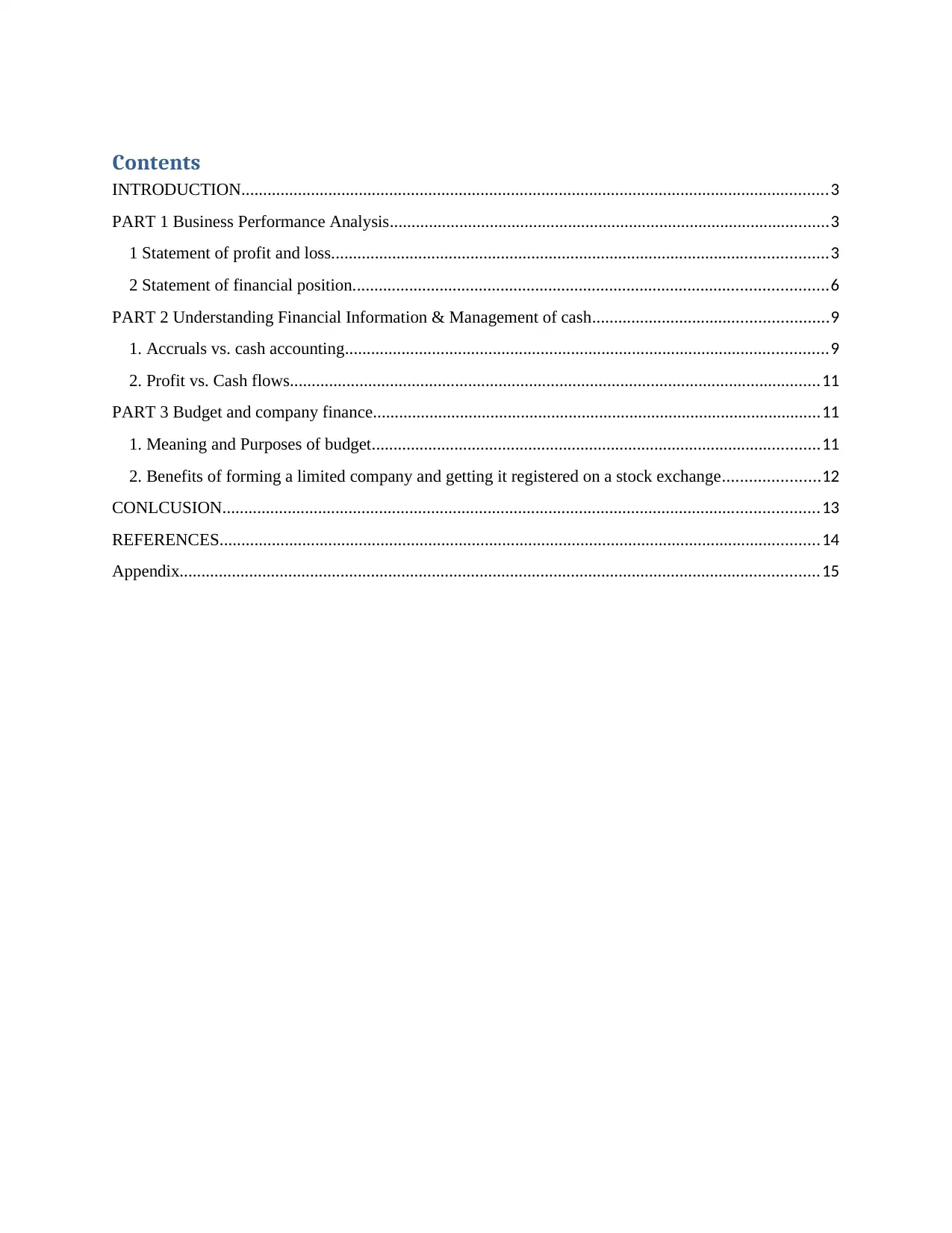
Contents
INTRODUCTION.......................................................................................................................................3
PART 1 Business Performance Analysis.....................................................................................................3
1 Statement of profit and loss..................................................................................................................3
2 Statement of financial position.............................................................................................................6
PART 2 Understanding Financial Information & Management of cash......................................................9
1. Accruals vs. cash accounting...............................................................................................................9
2. Profit vs. Cash flows..........................................................................................................................11
PART 3 Budget and company finance.......................................................................................................11
1. Meaning and Purposes of budget.......................................................................................................11
2. Benefits of forming a limited company and getting it registered on a stock exchange......................12
CONLCUSION.........................................................................................................................................13
REFERENCES..........................................................................................................................................14
Appendix...................................................................................................................................................15
INTRODUCTION.......................................................................................................................................3
PART 1 Business Performance Analysis.....................................................................................................3
1 Statement of profit and loss..................................................................................................................3
2 Statement of financial position.............................................................................................................6
PART 2 Understanding Financial Information & Management of cash......................................................9
1. Accruals vs. cash accounting...............................................................................................................9
2. Profit vs. Cash flows..........................................................................................................................11
PART 3 Budget and company finance.......................................................................................................11
1. Meaning and Purposes of budget.......................................................................................................11
2. Benefits of forming a limited company and getting it registered on a stock exchange......................12
CONLCUSION.........................................................................................................................................13
REFERENCES..........................................................................................................................................14
Appendix...................................................................................................................................................15
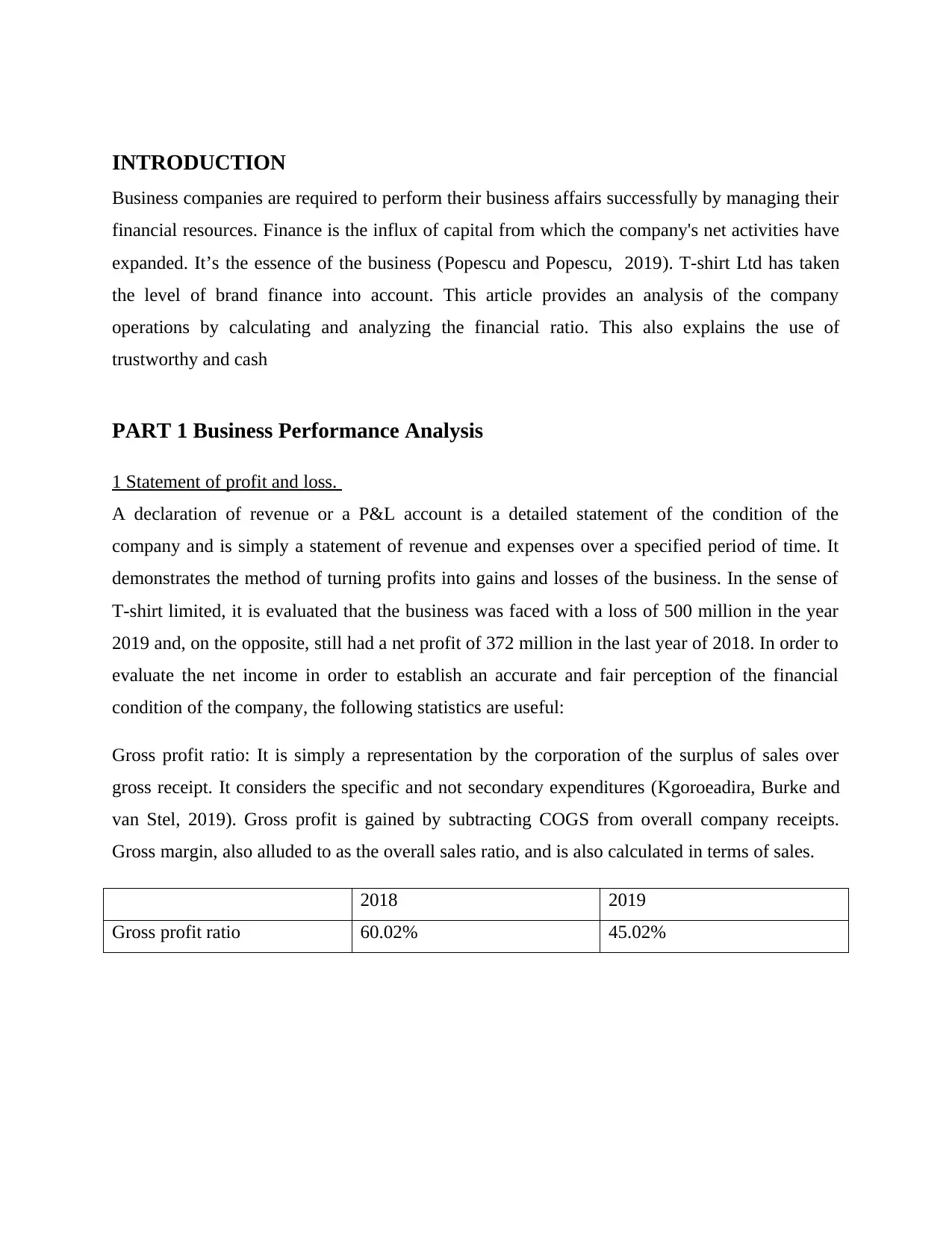
INTRODUCTION
Business companies are required to perform their business affairs successfully by managing their
financial resources. Finance is the influx of capital from which the company's net activities have
expanded. It’s the essence of the business (Popescu and Popescu, 2019). T-shirt Ltd has taken
the level of brand finance into account. This article provides an analysis of the company
operations by calculating and analyzing the financial ratio. This also explains the use of
trustworthy and cash
PART 1 Business Performance Analysis
1 Statement of profit and loss.
A declaration of revenue or a P&L account is a detailed statement of the condition of the
company and is simply a statement of revenue and expenses over a specified period of time. It
demonstrates the method of turning profits into gains and losses of the business. In the sense of
T-shirt limited, it is evaluated that the business was faced with a loss of 500 million in the year
2019 and, on the opposite, still had a net profit of 372 million in the last year of 2018. In order to
evaluate the net income in order to establish an accurate and fair perception of the financial
condition of the company, the following statistics are useful:
Gross profit ratio: It is simply a representation by the corporation of the surplus of sales over
gross receipt. It considers the specific and not secondary expenditures (Kgoroeadira, Burke and
van Stel, 2019). Gross profit is gained by subtracting COGS from overall company receipts.
Gross margin, also alluded to as the overall sales ratio, and is also calculated in terms of sales.
2018 2019
Gross profit ratio 60.02% 45.02%
Business companies are required to perform their business affairs successfully by managing their
financial resources. Finance is the influx of capital from which the company's net activities have
expanded. It’s the essence of the business (Popescu and Popescu, 2019). T-shirt Ltd has taken
the level of brand finance into account. This article provides an analysis of the company
operations by calculating and analyzing the financial ratio. This also explains the use of
trustworthy and cash
PART 1 Business Performance Analysis
1 Statement of profit and loss.
A declaration of revenue or a P&L account is a detailed statement of the condition of the
company and is simply a statement of revenue and expenses over a specified period of time. It
demonstrates the method of turning profits into gains and losses of the business. In the sense of
T-shirt limited, it is evaluated that the business was faced with a loss of 500 million in the year
2019 and, on the opposite, still had a net profit of 372 million in the last year of 2018. In order to
evaluate the net income in order to establish an accurate and fair perception of the financial
condition of the company, the following statistics are useful:
Gross profit ratio: It is simply a representation by the corporation of the surplus of sales over
gross receipt. It considers the specific and not secondary expenditures (Kgoroeadira, Burke and
van Stel, 2019). Gross profit is gained by subtracting COGS from overall company receipts.
Gross margin, also alluded to as the overall sales ratio, and is also calculated in terms of sales.
2018 2019
Gross profit ratio 60.02% 45.02%
⊘ This is a preview!⊘
Do you want full access?
Subscribe today to unlock all pages.

Trusted by 1+ million students worldwide
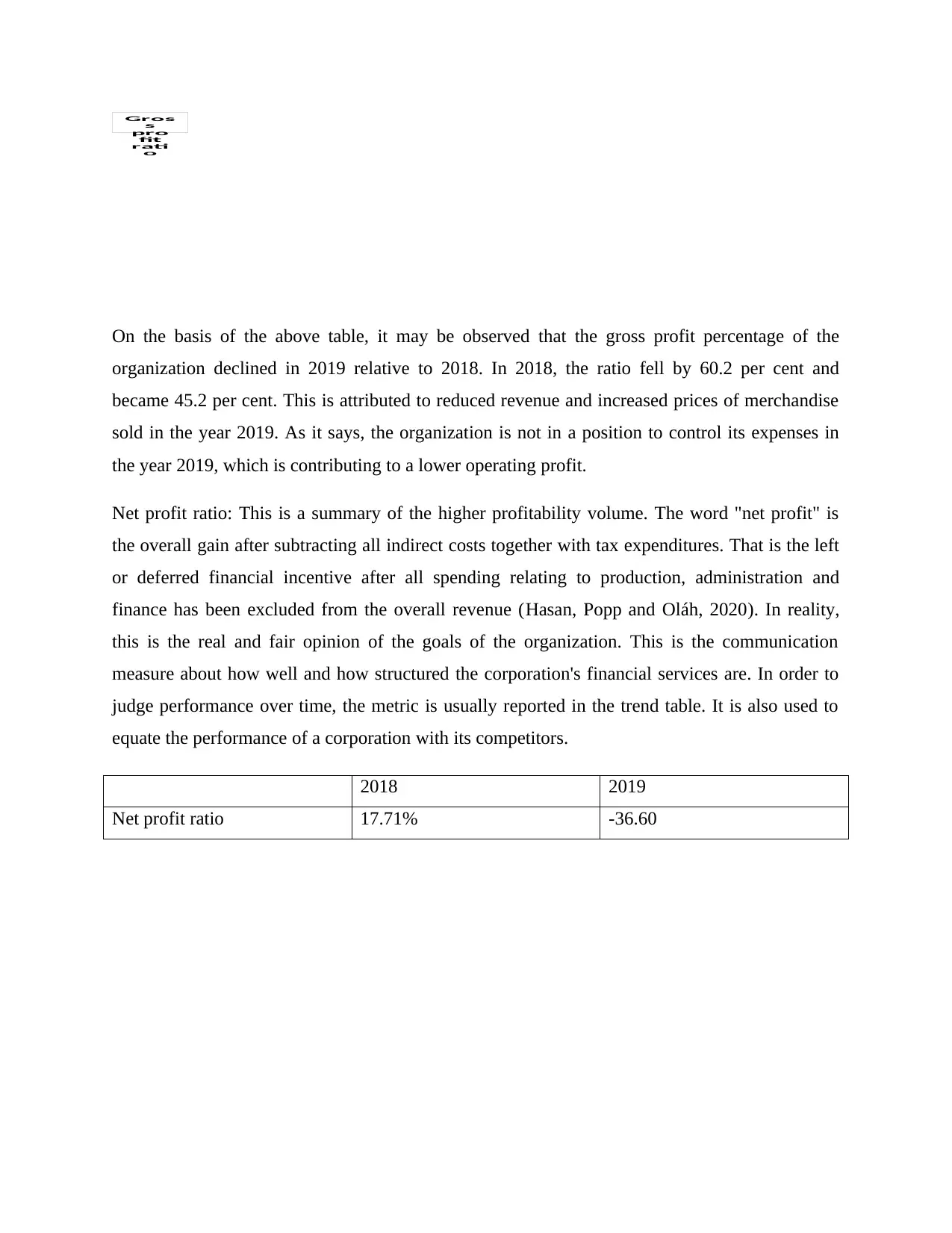
Gros
s
pro
fit
rati
o
On the basis of the above table, it may be observed that the gross profit percentage of the
organization declined in 2019 relative to 2018. In 2018, the ratio fell by 60.2 per cent and
became 45.2 per cent. This is attributed to reduced revenue and increased prices of merchandise
sold in the year 2019. As it says, the organization is not in a position to control its expenses in
the year 2019, which is contributing to a lower operating profit.
Net profit ratio: This is a summary of the higher profitability volume. The word "net profit" is
the overall gain after subtracting all indirect costs together with tax expenditures. That is the left
or deferred financial incentive after all spending relating to production, administration and
finance has been excluded from the overall revenue (Hasan, Popp and Oláh, 2020). In reality,
this is the real and fair opinion of the goals of the organization. This is the communication
measure about how well and how structured the corporation's financial services are. In order to
judge performance over time, the metric is usually reported in the trend table. It is also used to
equate the performance of a corporation with its competitors.
2018 2019
Net profit ratio 17.71% -36.60
s
pro
fit
rati
o
On the basis of the above table, it may be observed that the gross profit percentage of the
organization declined in 2019 relative to 2018. In 2018, the ratio fell by 60.2 per cent and
became 45.2 per cent. This is attributed to reduced revenue and increased prices of merchandise
sold in the year 2019. As it says, the organization is not in a position to control its expenses in
the year 2019, which is contributing to a lower operating profit.
Net profit ratio: This is a summary of the higher profitability volume. The word "net profit" is
the overall gain after subtracting all indirect costs together with tax expenditures. That is the left
or deferred financial incentive after all spending relating to production, administration and
finance has been excluded from the overall revenue (Hasan, Popp and Oláh, 2020). In reality,
this is the real and fair opinion of the goals of the organization. This is the communication
measure about how well and how structured the corporation's financial services are. In order to
judge performance over time, the metric is usually reported in the trend table. It is also used to
equate the performance of a corporation with its competitors.
2018 2019
Net profit ratio 17.71% -36.60
Paraphrase This Document
Need a fresh take? Get an instant paraphrase of this document with our AI Paraphraser
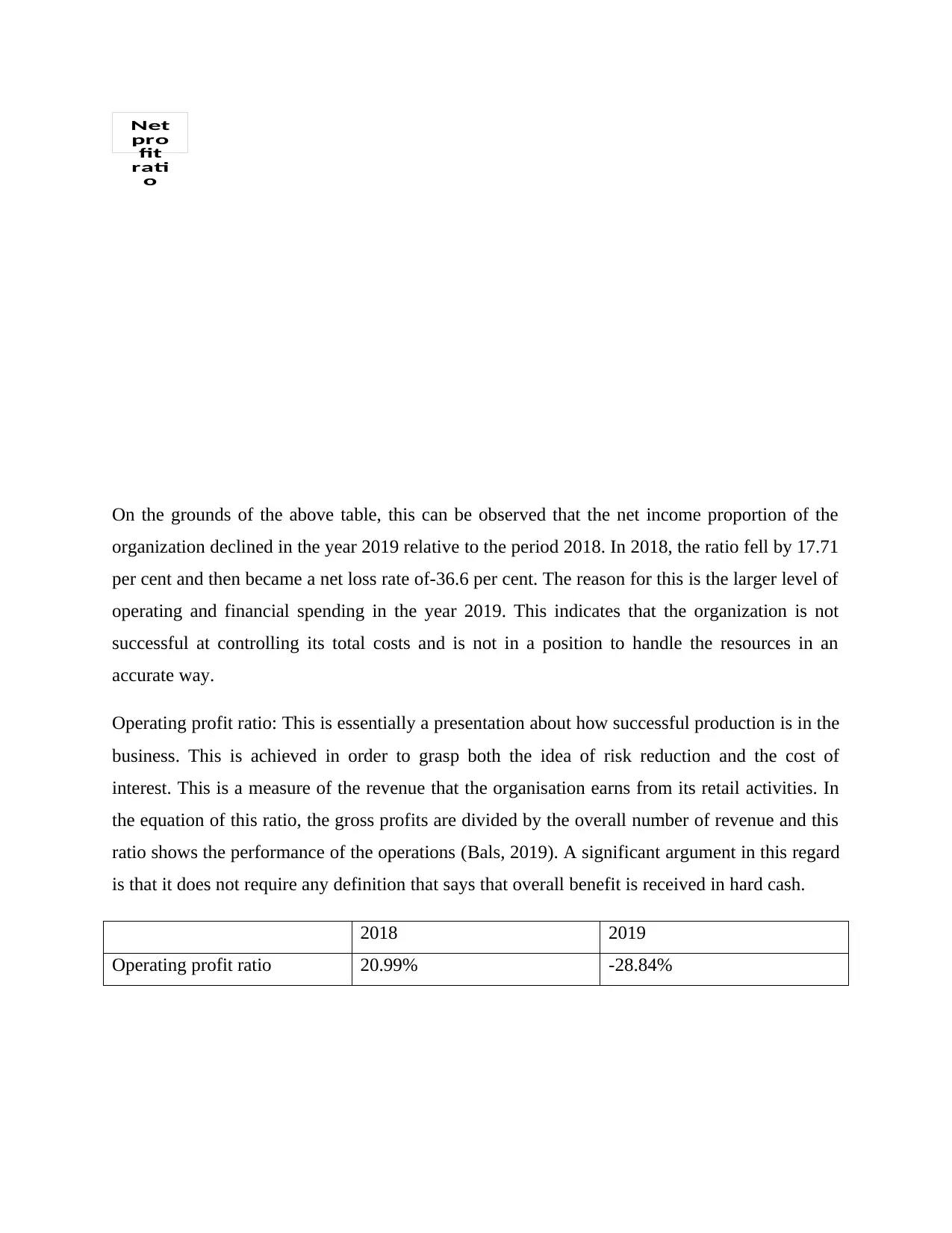
Net
pro
fit
rati
o
On the grounds of the above table, this can be observed that the net income proportion of the
organization declined in the year 2019 relative to the period 2018. In 2018, the ratio fell by 17.71
per cent and then became a net loss rate of-36.6 per cent. The reason for this is the larger level of
operating and financial spending in the year 2019. This indicates that the organization is not
successful at controlling its total costs and is not in a position to handle the resources in an
accurate way.
Operating profit ratio: This is essentially a presentation about how successful production is in the
business. This is achieved in order to grasp both the idea of risk reduction and the cost of
interest. This is a measure of the revenue that the organisation earns from its retail activities. In
the equation of this ratio, the gross profits are divided by the overall number of revenue and this
ratio shows the performance of the operations (Bals, 2019). A significant argument in this regard
is that it does not require any definition that says that overall benefit is received in hard cash.
2018 2019
Operating profit ratio 20.99% -28.84%
pro
fit
rati
o
On the grounds of the above table, this can be observed that the net income proportion of the
organization declined in the year 2019 relative to the period 2018. In 2018, the ratio fell by 17.71
per cent and then became a net loss rate of-36.6 per cent. The reason for this is the larger level of
operating and financial spending in the year 2019. This indicates that the organization is not
successful at controlling its total costs and is not in a position to handle the resources in an
accurate way.
Operating profit ratio: This is essentially a presentation about how successful production is in the
business. This is achieved in order to grasp both the idea of risk reduction and the cost of
interest. This is a measure of the revenue that the organisation earns from its retail activities. In
the equation of this ratio, the gross profits are divided by the overall number of revenue and this
ratio shows the performance of the operations (Bals, 2019). A significant argument in this regard
is that it does not require any definition that says that overall benefit is received in hard cash.
2018 2019
Operating profit ratio 20.99% -28.84%
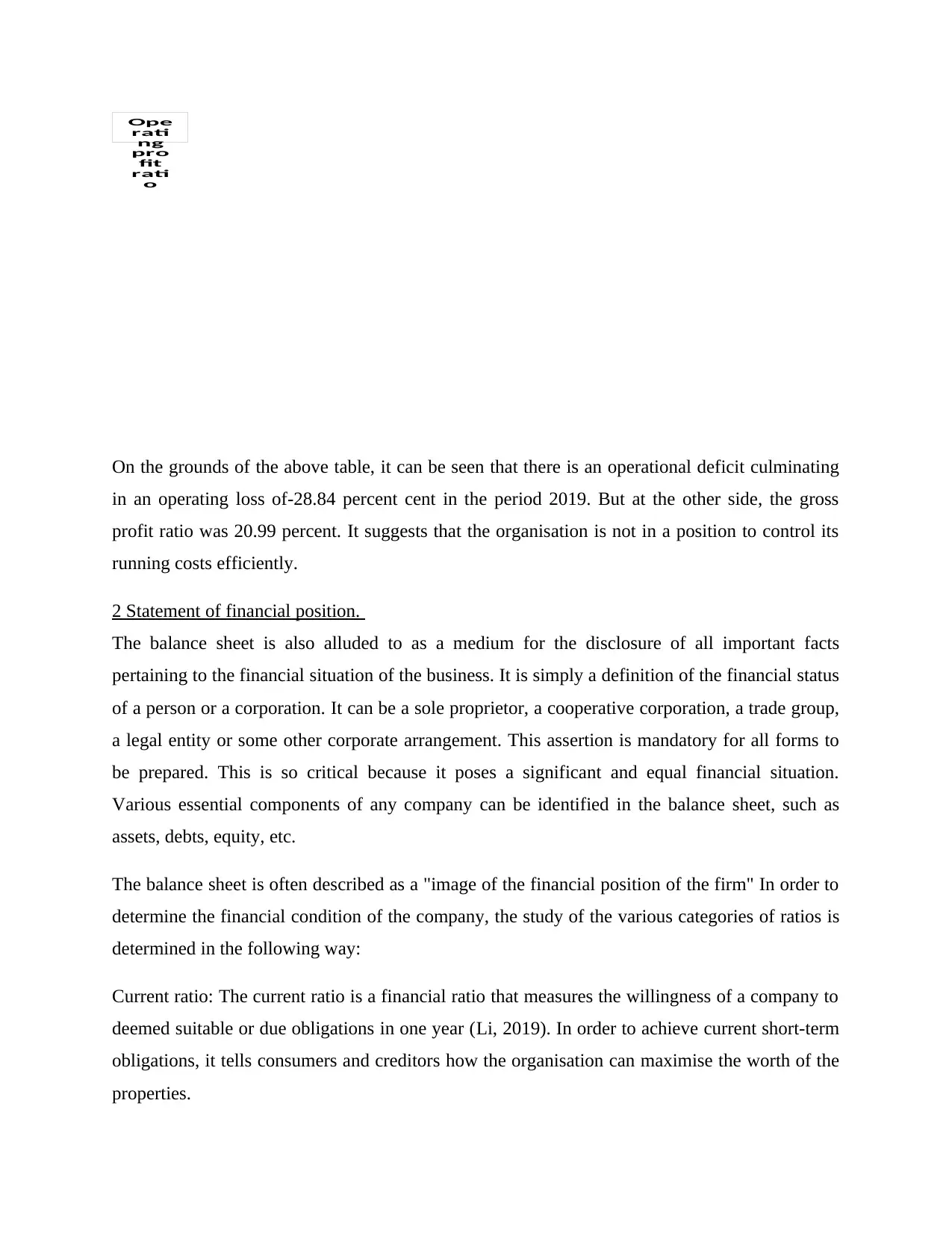
Ope
rati
ng
pro
fit
rati
o
On the grounds of the above table, it can be seen that there is an operational deficit culminating
in an operating loss of-28.84 percent cent in the period 2019. But at the other side, the gross
profit ratio was 20.99 percent. It suggests that the organisation is not in a position to control its
running costs efficiently.
2 Statement of financial position.
The balance sheet is also alluded to as a medium for the disclosure of all important facts
pertaining to the financial situation of the business. It is simply a definition of the financial status
of a person or a corporation. It can be a sole proprietor, a cooperative corporation, a trade group,
a legal entity or some other corporate arrangement. This assertion is mandatory for all forms to
be prepared. This is so critical because it poses a significant and equal financial situation.
Various essential components of any company can be identified in the balance sheet, such as
assets, debts, equity, etc.
The balance sheet is often described as a "image of the financial position of the firm" In order to
determine the financial condition of the company, the study of the various categories of ratios is
determined in the following way:
Current ratio: The current ratio is a financial ratio that measures the willingness of a company to
deemed suitable or due obligations in one year (Li, 2019). In order to achieve current short-term
obligations, it tells consumers and creditors how the organisation can maximise the worth of the
properties.
rati
ng
pro
fit
rati
o
On the grounds of the above table, it can be seen that there is an operational deficit culminating
in an operating loss of-28.84 percent cent in the period 2019. But at the other side, the gross
profit ratio was 20.99 percent. It suggests that the organisation is not in a position to control its
running costs efficiently.
2 Statement of financial position.
The balance sheet is also alluded to as a medium for the disclosure of all important facts
pertaining to the financial situation of the business. It is simply a definition of the financial status
of a person or a corporation. It can be a sole proprietor, a cooperative corporation, a trade group,
a legal entity or some other corporate arrangement. This assertion is mandatory for all forms to
be prepared. This is so critical because it poses a significant and equal financial situation.
Various essential components of any company can be identified in the balance sheet, such as
assets, debts, equity, etc.
The balance sheet is often described as a "image of the financial position of the firm" In order to
determine the financial condition of the company, the study of the various categories of ratios is
determined in the following way:
Current ratio: The current ratio is a financial ratio that measures the willingness of a company to
deemed suitable or due obligations in one year (Li, 2019). In order to achieve current short-term
obligations, it tells consumers and creditors how the organisation can maximise the worth of the
properties.
⊘ This is a preview!⊘
Do you want full access?
Subscribe today to unlock all pages.

Trusted by 1+ million students worldwide
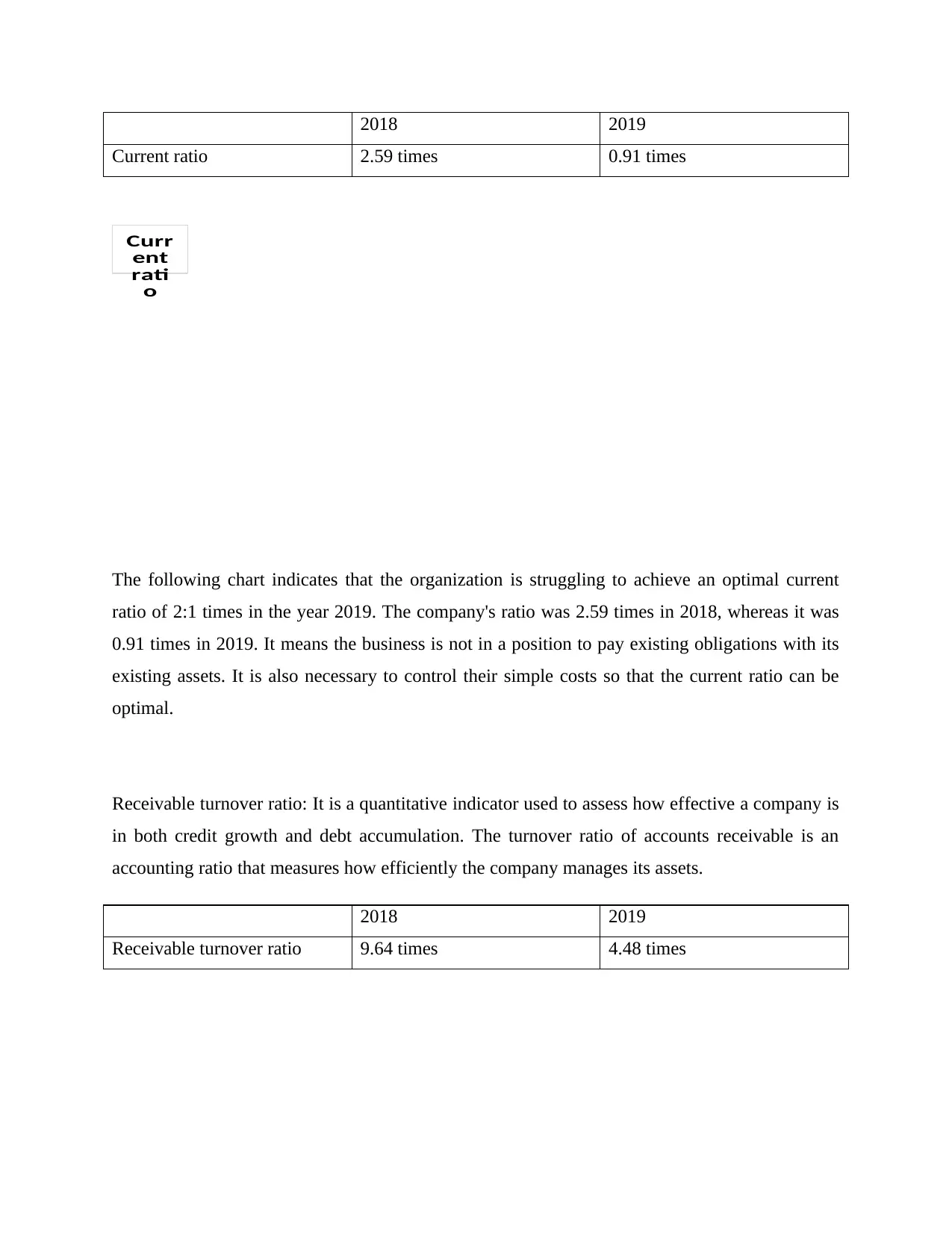
2018 2019
Current ratio 2.59 times 0.91 times
Curr
ent
rati
o
The following chart indicates that the organization is struggling to achieve an optimal current
ratio of 2:1 times in the year 2019. The company's ratio was 2.59 times in 2018, whereas it was
0.91 times in 2019. It means the business is not in a position to pay existing obligations with its
existing assets. It is also necessary to control their simple costs so that the current ratio can be
optimal.
Receivable turnover ratio: It is a quantitative indicator used to assess how effective a company is
in both credit growth and debt accumulation. The turnover ratio of accounts receivable is an
accounting ratio that measures how efficiently the company manages its assets.
2018 2019
Receivable turnover ratio 9.64 times 4.48 times
Current ratio 2.59 times 0.91 times
Curr
ent
rati
o
The following chart indicates that the organization is struggling to achieve an optimal current
ratio of 2:1 times in the year 2019. The company's ratio was 2.59 times in 2018, whereas it was
0.91 times in 2019. It means the business is not in a position to pay existing obligations with its
existing assets. It is also necessary to control their simple costs so that the current ratio can be
optimal.
Receivable turnover ratio: It is a quantitative indicator used to assess how effective a company is
in both credit growth and debt accumulation. The turnover ratio of accounts receivable is an
accounting ratio that measures how efficiently the company manages its assets.
2018 2019
Receivable turnover ratio 9.64 times 4.48 times
Paraphrase This Document
Need a fresh take? Get an instant paraphrase of this document with our AI Paraphraser
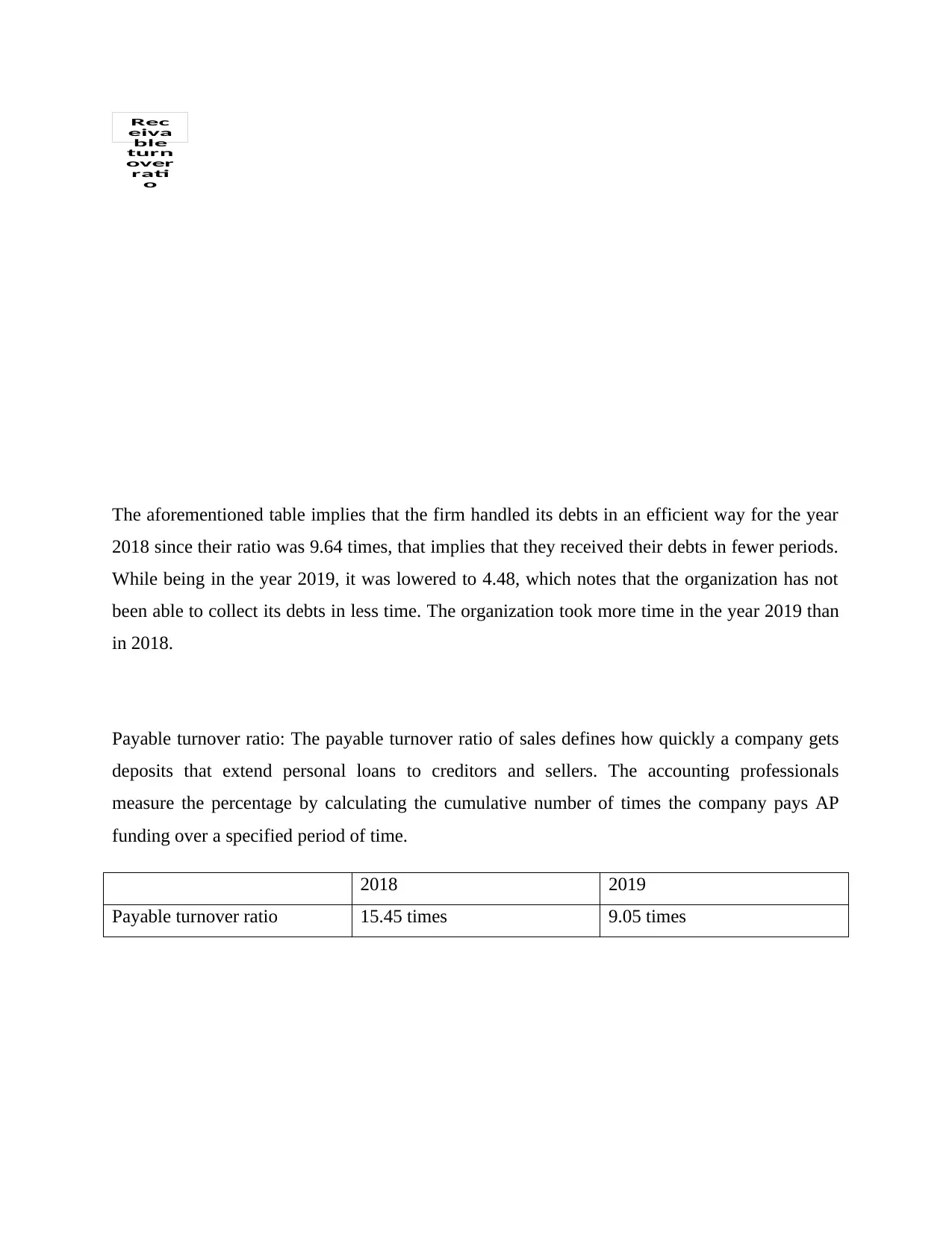
Rec
eiva
ble
turn
over
rati
o
The aforementioned table implies that the firm handled its debts in an efficient way for the year
2018 since their ratio was 9.64 times, that implies that they received their debts in fewer periods.
While being in the year 2019, it was lowered to 4.48, which notes that the organization has not
been able to collect its debts in less time. The organization took more time in the year 2019 than
in 2018.
Payable turnover ratio: The payable turnover ratio of sales defines how quickly a company gets
deposits that extend personal loans to creditors and sellers. The accounting professionals
measure the percentage by calculating the cumulative number of times the company pays AP
funding over a specified period of time.
2018 2019
Payable turnover ratio 15.45 times 9.05 times
eiva
ble
turn
over
rati
o
The aforementioned table implies that the firm handled its debts in an efficient way for the year
2018 since their ratio was 9.64 times, that implies that they received their debts in fewer periods.
While being in the year 2019, it was lowered to 4.48, which notes that the organization has not
been able to collect its debts in less time. The organization took more time in the year 2019 than
in 2018.
Payable turnover ratio: The payable turnover ratio of sales defines how quickly a company gets
deposits that extend personal loans to creditors and sellers. The accounting professionals
measure the percentage by calculating the cumulative number of times the company pays AP
funding over a specified period of time.
2018 2019
Payable turnover ratio 15.45 times 9.05 times

Pay
able
turn
over
rati
o
The aforementioned table indicates that the organization handled its obligations in a successful
way for 2018 when their ratio was 15.45 times, which means that they settled their debts in fewer
periods. Although in the year 2019, it decreased and became 9.05 times that the business has not
been able to pay its obligations in less time. The organization took more time in the year 2019
than in 2018.
PART 2 Understanding Financial Information & Management of cash
1. Accruals vs. cash accounting
There are essentially two ways of paying for firms. These approaches vary in only one point that
is the nature of a payment (Motta, 2020). Both approaches have separate rhythms in relation to
the determination of revenue and expenditure according to the pace of documenting them in the
records of accounting. More clearly, it should be claimed that the cash form of accounting only
defines and documents all activities concerning the sale of hard cash or its alternatives. In the
other side, the accrual approach does not have this form of distinction and applies the monetary
principle. As per this definition, all purchases should be calculated in nominal values, whether or
not hard cash is involved.
Accrual accounting method:
As per this system of accounting, a sale is registered whether it can be calculated in cash at the
very same time. In the case of wages, it is normally registered right before the hand of actual
able
turn
over
rati
o
The aforementioned table indicates that the organization handled its obligations in a successful
way for 2018 when their ratio was 15.45 times, which means that they settled their debts in fewer
periods. Although in the year 2019, it decreased and became 9.05 times that the business has not
been able to pay its obligations in less time. The organization took more time in the year 2019
than in 2018.
PART 2 Understanding Financial Information & Management of cash
1. Accruals vs. cash accounting
There are essentially two ways of paying for firms. These approaches vary in only one point that
is the nature of a payment (Motta, 2020). Both approaches have separate rhythms in relation to
the determination of revenue and expenditure according to the pace of documenting them in the
records of accounting. More clearly, it should be claimed that the cash form of accounting only
defines and documents all activities concerning the sale of hard cash or its alternatives. In the
other side, the accrual approach does not have this form of distinction and applies the monetary
principle. As per this definition, all purchases should be calculated in nominal values, whether or
not hard cash is involved.
Accrual accounting method:
As per this system of accounting, a sale is registered whether it can be calculated in cash at the
very same time. In the case of wages, it is normally registered right before the hand of actual
⊘ This is a preview!⊘
Do you want full access?
Subscribe today to unlock all pages.

Trusted by 1+ million students worldwide

money transactions. In the currency method, the transaction will only be reported at the point of
time where it includes the exchanging of cash. If there is the opportunity for gain or spending in
any payment, the amount would be recorded in the accounting records on the same day.
Advantages: The most significant knowledge in this regard is that the principle of accrual is to
document both invoice and expenditure on the very same period. And this helps in the
presentation of an absolute accurate and honest image of the company's success. In fact, this
definition is very worthwhile in the short run. The logic appears to be that all profits are
registered by the repayment scheme when they are earned and all expenses when they are
accrued. For example, in the present year a company will have profits that will not be registered
under the cash system, since income is not required till the next cycle (Creehan, 2019). An
investor may assume that the corporation is unprofitable when the firm is doing too well.
Disadvantages: Despite all the positives, this strategy still has some drawbacks. The biggest
downside to this approach is that it does not take into account the cash flows of the business.
This strategy may be a very appropriate and cost-effective approach in the long run, but due to
the lack of consideration of cash flows, there may be a significant short-term deficit in cash
levels. As a result, any process that needs cash flow and real money will be hidden. The
drawback to the repayment method is it's harder to implement because problems such as
unwarranted salaries and unpaid expenses have to be taken into account.
Cash basis accounting
As per this method, transfers will only be reported in the accounting records if any exchange of
cash money or alternatives is made. Exchanges that do not include any capital transactions will
not be recorded in the accounting period, such as depletion. This method is not used by major
companies but is acceptable for small businesses and their associated financial situation, where
cash is perceived to be the primary mode of transactions.
Advantages: Cash methodology has the greatest benefit because it calculates the cash level with
total effectiveness (Wellalage and Fernandez, 2019). It just accounts for cash expended or
received in a given amount of time. If this method is practised in a business, even the difficult
task of managing cash flows becomes simpler.
time where it includes the exchanging of cash. If there is the opportunity for gain or spending in
any payment, the amount would be recorded in the accounting records on the same day.
Advantages: The most significant knowledge in this regard is that the principle of accrual is to
document both invoice and expenditure on the very same period. And this helps in the
presentation of an absolute accurate and honest image of the company's success. In fact, this
definition is very worthwhile in the short run. The logic appears to be that all profits are
registered by the repayment scheme when they are earned and all expenses when they are
accrued. For example, in the present year a company will have profits that will not be registered
under the cash system, since income is not required till the next cycle (Creehan, 2019). An
investor may assume that the corporation is unprofitable when the firm is doing too well.
Disadvantages: Despite all the positives, this strategy still has some drawbacks. The biggest
downside to this approach is that it does not take into account the cash flows of the business.
This strategy may be a very appropriate and cost-effective approach in the long run, but due to
the lack of consideration of cash flows, there may be a significant short-term deficit in cash
levels. As a result, any process that needs cash flow and real money will be hidden. The
drawback to the repayment method is it's harder to implement because problems such as
unwarranted salaries and unpaid expenses have to be taken into account.
Cash basis accounting
As per this method, transfers will only be reported in the accounting records if any exchange of
cash money or alternatives is made. Exchanges that do not include any capital transactions will
not be recorded in the accounting period, such as depletion. This method is not used by major
companies but is acceptable for small businesses and their associated financial situation, where
cash is perceived to be the primary mode of transactions.
Advantages: Cash methodology has the greatest benefit because it calculates the cash level with
total effectiveness (Wellalage and Fernandez, 2019). It just accounts for cash expended or
received in a given amount of time. If this method is practised in a business, even the difficult
task of managing cash flows becomes simpler.
Paraphrase This Document
Need a fresh take? Get an instant paraphrase of this document with our AI Paraphraser

Disadvantages: There are also some drawbacks to this strategy. It might overestimate the
profitability of a cash-rich company with a huge number of accounting documents that far
overshadow the cash, mainly on the books, and the real income stream of the company. The
investor will assume that the business makes money whenever the business simply makes a loss.
2. Profit vs. Cash flows
The most distinguishing characteristic of all words is that gains are the cumulative total of all
revenue (whether in cash or not) overall spending. On the other hand, currency is only a
calculation of gross revenue in cash. This means surplus financial profits above gross cash
expenditures.
Cash is a type of trade tool that is constantly going out and in the business. For example, when a
merchant orders a stock outside his company, he will offer cash in return for the stocks that he
purchases (Asongu and Odhiambo, 2019). In this situation, as the same merchant who purchased
the inventory from other merchants wants to begin selling the stock, the cash would flow out of
the business. Businesses involved in various transactions, such as paying taxes, wages or
electrical bills, and both of these transactions often require some sort of exchanging of currency.
It is inferred from all these conversations that there is a steady supply of cash in the company.
Profits are described as the quantity of money left to the company after all costs have been
incurred. This figure covers all forms of taxes, whether earned in the form of cash or not. That is
what is remaining after the books are closed and the expenses are deducted from earnings.
Benefit can either be distributed to business investors and creditors, often by dividend payments,
or can be re-invested in the firm. Profit may be used for example, to purchase additional shares
for a business to sell or to finance research and production of new products and services.
PART 3 Budget and company finance
1. Meaning and Purposes of budget
The budget shall be defined as the schedule or strategy of any given organization and shall be
devised on the basis of statistical values. These arrangements are conceived in financial terms
and could be for a fixed time span of one month to two years. Many businesses claim that they
profitability of a cash-rich company with a huge number of accounting documents that far
overshadow the cash, mainly on the books, and the real income stream of the company. The
investor will assume that the business makes money whenever the business simply makes a loss.
2. Profit vs. Cash flows
The most distinguishing characteristic of all words is that gains are the cumulative total of all
revenue (whether in cash or not) overall spending. On the other hand, currency is only a
calculation of gross revenue in cash. This means surplus financial profits above gross cash
expenditures.
Cash is a type of trade tool that is constantly going out and in the business. For example, when a
merchant orders a stock outside his company, he will offer cash in return for the stocks that he
purchases (Asongu and Odhiambo, 2019). In this situation, as the same merchant who purchased
the inventory from other merchants wants to begin selling the stock, the cash would flow out of
the business. Businesses involved in various transactions, such as paying taxes, wages or
electrical bills, and both of these transactions often require some sort of exchanging of currency.
It is inferred from all these conversations that there is a steady supply of cash in the company.
Profits are described as the quantity of money left to the company after all costs have been
incurred. This figure covers all forms of taxes, whether earned in the form of cash or not. That is
what is remaining after the books are closed and the expenses are deducted from earnings.
Benefit can either be distributed to business investors and creditors, often by dividend payments,
or can be re-invested in the firm. Profit may be used for example, to purchase additional shares
for a business to sell or to finance research and production of new products and services.
PART 3 Budget and company finance
1. Meaning and Purposes of budget
The budget shall be defined as the schedule or strategy of any given organization and shall be
devised on the basis of statistical values. These arrangements are conceived in financial terms
and could be for a fixed time span of one month to two years. Many businesses claim that they

will adhere to their budgetary budgets over the time span, reflecting the projected costs that the
organization expects to pay in order to meet its cost centers while concentrating on meeting
sustainability goals.
Budgets are prepared to serve following purposes:
• Serves as an assistance mechanism in the design and implementation of the ability to pay short
aims and priorities.
• Simply, this is a way of shifting business obligations to the accountable centre management.
• Budget shall ensure that management is motivated to fulfill the strategic goals of their specific
transparency centers.
• This serves as a basis, basis or reference point on which the management of the business can
take off subsequent activities in a more productive manner.
2. Benefits of forming a limited company and getting it registered on a stock exchange
In the United Kingdom, limited partnership is the most commonly adopted legal framework for
all modes of companies. There are several technological and financial benefits associated with
the idea of Limited Liability Company. These benefits go beyond the benefits that this corporate
system provides with other independent retailers or contractors operating in the same line of
operation.
The most obvious benefit of this situation is that the developer has the right to develop his own
company with a protection of liability protection (Biancone, Secinaro and Kamal, 2019). In other
words, it can be described as the condition in which the company is complicated, however the
individual's personal properties are secured. Another significant advantage that this strong
professional is that it has a different legal body and that it therefore has every lawful authority
that a person may possess. Owing to the idea of a distinct legal body, the corporation has become
a separate name on the market and this constitutes an abstract "corporate veil." Any debt,
obligation or conflict concerning the company is the obligation of the company itself – never of
all its owners.
organization expects to pay in order to meet its cost centers while concentrating on meeting
sustainability goals.
Budgets are prepared to serve following purposes:
• Serves as an assistance mechanism in the design and implementation of the ability to pay short
aims and priorities.
• Simply, this is a way of shifting business obligations to the accountable centre management.
• Budget shall ensure that management is motivated to fulfill the strategic goals of their specific
transparency centers.
• This serves as a basis, basis or reference point on which the management of the business can
take off subsequent activities in a more productive manner.
2. Benefits of forming a limited company and getting it registered on a stock exchange
In the United Kingdom, limited partnership is the most commonly adopted legal framework for
all modes of companies. There are several technological and financial benefits associated with
the idea of Limited Liability Company. These benefits go beyond the benefits that this corporate
system provides with other independent retailers or contractors operating in the same line of
operation.
The most obvious benefit of this situation is that the developer has the right to develop his own
company with a protection of liability protection (Biancone, Secinaro and Kamal, 2019). In other
words, it can be described as the condition in which the company is complicated, however the
individual's personal properties are secured. Another significant advantage that this strong
professional is that it has a different legal body and that it therefore has every lawful authority
that a person may possess. Owing to the idea of a distinct legal body, the corporation has become
a separate name on the market and this constitutes an abstract "corporate veil." Any debt,
obligation or conflict concerning the company is the obligation of the company itself – never of
all its owners.
⊘ This is a preview!⊘
Do you want full access?
Subscribe today to unlock all pages.

Trusted by 1+ million students worldwide
1 out of 16
Related Documents
Your All-in-One AI-Powered Toolkit for Academic Success.
+13062052269
info@desklib.com
Available 24*7 on WhatsApp / Email
![[object Object]](/_next/static/media/star-bottom.7253800d.svg)
Unlock your academic potential
Copyright © 2020–2025 A2Z Services. All Rights Reserved. Developed and managed by ZUCOL.





